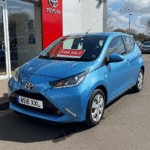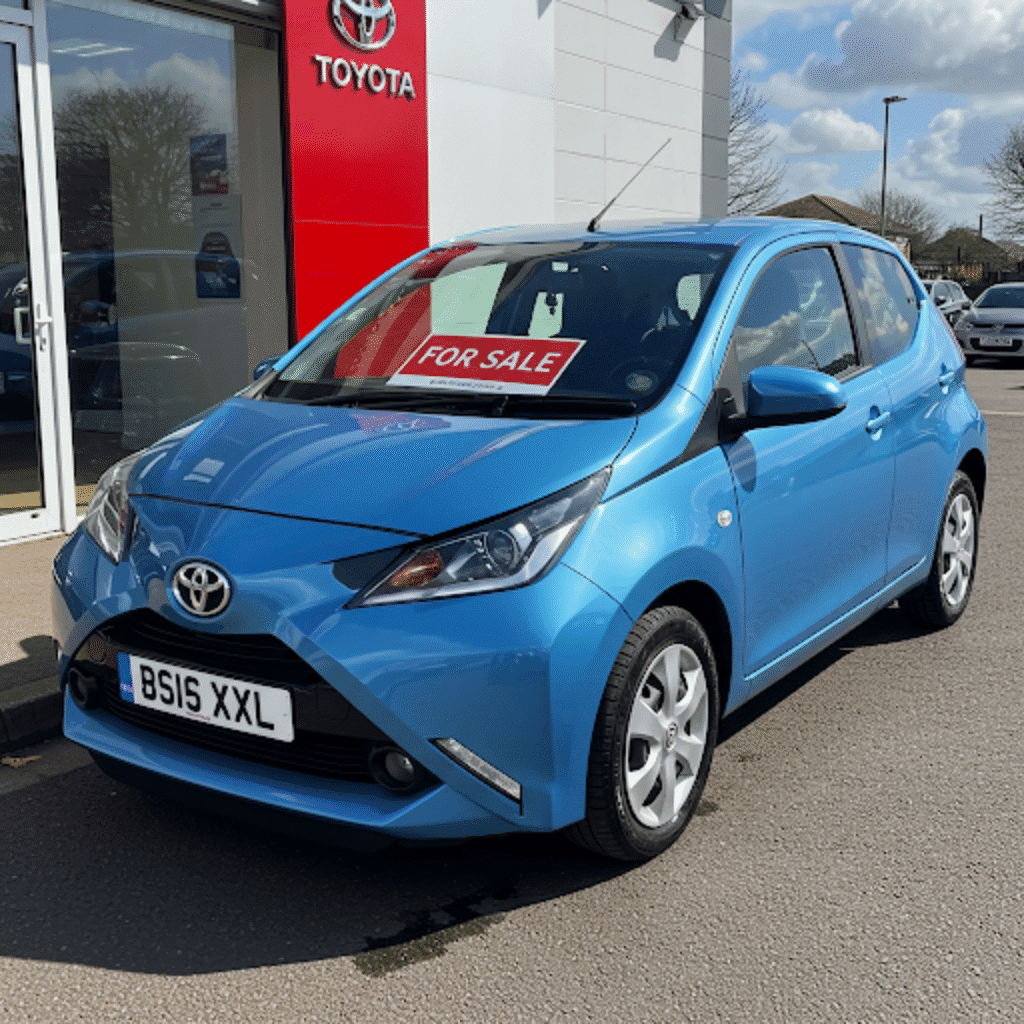
Finding Your Perfect Toyota Aygo for Sale in the UK
Ah, the Toyota Aygo. If you’ve spent any time driving around UK towns and cities, you’ve undoubtedly seen plenty of these characterful little cars zipping about. Since its arrival back in 2005, the Aygo has carved out a significant niche for itself, becoming a firm favourite amongst new drivers, city dwellers, and anyone seeking affordable, reliable, and stylish motoring. It’s a car that proves budget-friendly doesn’t have to mean boring or basic.
But with nearly two decades of history and multiple generations now available on the used market, alongside the newer Aygo X model, navigating the world of ‘Toyota Aygo for sale’ listings can seem a bit daunting. Where do you start? What should you look for? Which model is right for you? Fear not! This guide is here to help you understand the enduring appeal of the Aygo and equip you with the knowledge to find the perfect one for your needs and budget right here in the UK.
A Little Bit of Aygo History

The Aygo wasn’t just a solo effort from Toyota. It was born from a rather clever collaboration initiated in the early 2000s. Toyota teamed up with PSA Peugeot Citroën (now part of Stellantis) to create a trio of city cars that shared the same basic platform, engines, and core structure, but each had its own distinct personality and styling cues. This joint venture allowed the manufacturers to share development costs and produce genuinely affordable small cars perfect for the European market. The result? The Toyota Aygo, the Peugeot 107, and the Citroën C1, all rolling off the same production line in Kolín, Czech Republic. The Aygo, often seen as the slightly more distinctively styled of the three, immediately struck a chord with UK buyers looking for Japanese reliability combined with European chic and incredibly low running costs.
Generation Game: Which Aygo is Which?
Understanding the different iterations of the Aygo is key to finding the right one for sale.
Mark 1 (2005 – 2014): The Original City Slicker
Launched in 2005, the first-generation Aygo was a breath of fresh air. Small, lightweight, and powered by a characterful 1.0-litre, three-cylinder petrol engine (a 1.4-litre diesel was briefly offered but is rare and generally less desirable), it was incredibly economical and surprisingly fun to drive, especially around town. Its cheeky styling, simple interior, and low price point made it an instant hit.
- Design: Rounded, friendly appearance. Available in three and five-door body styles. Early models had grey bumpers on base trims, while higher specs got body-coloured ones.
- Facelifts: Received updates in 2009 and 2012. These mainly involved cosmetic tweaks to the front bumper and lights, interior trim updates, and minor mechanical refinements to improve emissions and fuel economy. The 2012 facelift brought LED daytime running lights to some models.
- Trims: Common trims included Aygo, Aygo+, Aygo Sport, Aygo Black, and Aygo Blue. Features were basic on entry models (manual windows, no central locking sometimes), but higher specs added air conditioning, alloy wheels, and electric windows. Special editions popped up frequently.
- Things to Note: Early Mk1s are now very affordable but check carefully for wear and tear. Common issues to look for include water leaks into the boot (check the spare wheel well for dampness) and around door seals, clutch wear (especially if it’s lived its life in heavy traffic), and exhaust system corrosion. Despite these potential niggles, the fundamental mechanicals are famously robust.
Mark 2 (2014 – 2022): The Bold ‘X’ Factor
Toyota decided to inject a hefty dose of personality into the second-generation Aygo. Unveiled in 2014, its most striking feature was the prominent ‘X’ graphic dominating the front end, giving it a much more aggressive and customisable look. While still sharing its platform with the new Peugeot 108 and Citroën C1, the Aygo Mk2 felt like a more substantial step up from its predecessor.
- Design: Sharp, angular styling with the distinctive ‘X’ motif available in contrasting colours. Again, offered in three and five-door forms initially, though three-door models became less common later on. The focus was heavily on personalisation.
- Improvements: Interior quality took a noticeable leap forward with better materials and a more modern dashboard design. Refinement was improved, though still a city car at heart. The 1.0-litre VVT-i petrol engine was updated for better efficiency and slightly more power (output varied slightly over its life but hovered around 68-71 bhp).
- Technology: Higher trim levels gained the ‘x-touch’ infotainment system – a 7-inch touchscreen controlling audio, Bluetooth, and often featuring a reversing camera. Apple CarPlay and Android Auto compatibility arrived later in the Mk2’s life cycle on selected models.
- Trims: Toyota adopted an ‘x-themed’ naming convention: x, x-play, x-pression, x-cite, x-clusiv, x-trend, x-pure. ‘x-play’ often represented the sweet spot for equipment. Numerous special editions continued, offering unique colour combinations and extra kit.
- Safety: Received a better Euro NCAP safety rating than the Mk1, especially when equipped with the optional ‘Toyota Safety Sense’ package (introduced around 2017/2018) which included features like a Pre-Collision System and Lane Departure Alert.
- Things to Note: Generally holds its value better than the Mk1. Build quality feels more solid. Check the infotainment system works correctly and that any optional safety features specified are present. Clutch and exhaust checks still apply, as with any used car.
Aygo X (2022 – Present): The Urban Crossover
Recognising the shift in market trends towards SUVs and crossovers, Toyota completely reinvented the Aygo for its third act, launching the Aygo X (pronounced ‘Cross’) in 2022. This isn’t just a facelift; it’s an entirely new car built on Toyota’s modern GA-B platform (shared with the Yaris and Yaris Cross), moving away from the PSA collaboration.
- Design: Taller stance, chunkier styling with plastic wheel arch cladding, and a more rugged appearance – very much a mini-crossover. Available only as a five-door. Retains a playful character but feels significantly more substantial.
- Size & Practicality: Noticeably larger than previous Aygos – longer, wider, and taller, with a higher driving position. This translates to more interior space (especially headroom) and a significantly bigger boot (231 litres vs the Mk2’s 168 litres), addressing a key criticism of older models.
- Platform & Drive: The new platform brings big improvements in ride comfort, handling stability, and refinement compared to previous generations. It feels much more grown-up and capable, even outside the city limits. The engine is a refined version of the familiar 1.0-litre three-cylinder petrol, offering around 71 bhp. Available with a manual gearbox or an S-CVT automatic.
- Technology & Safety: Comes with much more standard kit, including larger touchscreens (up to 9-inch Toyota Smart Connect system), comprehensive smartphone integration, and a suite of standard safety features under the Toyota Safety Sense banner (including adaptive cruise control on some models).
- Positioning: It’s positioned slightly higher in the market than its predecessors, reflecting its increased size, improved quality, and enhanced technology. It competes less directly with the traditional city car trio and more with other small crossovers and higher-spec superminis.
Why Should You Consider Buying a Toyota Aygo?
Whether you’re looking at a budget-friendly Mk1 or a nearly-new Aygo X, the core appeal remains consistent:
- Affordability: Purchase prices for used Aygos are highly competitive. Early Mk1s can be picked up for very little money, making them ideal first cars or runabouts. Even later Mk2s offer great value.
- Rock-Bottom Running Costs: This is the Aygo’s superpower. The 1.0-litre engine is incredibly frugal, easily capable of achieving over 50mpg (and often much more) in real-world driving. Insurance groups are typically very low (often group 1-5 for earlier models), making it exceptionally cheap to insure, especially for young drivers. Road tax is also minimal – many models registered before April 1st, 2017, qualify for £0 or £20 annual tax, while later models fall under the standard rate (£190 per year as of 2024/25 for petrol cars), which is still reasonable.
- Legendary Reliability: It’s a Toyota. While the Aygo was a joint venture, it benefits immensely from Toyota’s engineering prowess and reputation for dependability. The 1.0-litre engine is known for its robustness, and the simple mechanics mean there’s generally less to go wrong compared to more complex cars.
- Perfect City Manners: Its compact dimensions, light steering, and excellent turning circle make navigating tight city streets, tackling multi-storey car parks, and squeezing into tiny parking spaces an absolute breeze.
- Surprising Fun Factor: Don’t let the small engine fool you. The Aygo’s light weight and eager three-cylinder engine make it feel nippy and responsive around town. It’s not fast, but it can certainly put a smile on your face during the urban commute.
- Style and Personalisation: Especially from the Mk2 onwards, the Aygo offered plenty of scope for personalisation with contrasting roof colours, interior trim details, and numerous special editions, allowing buyers to find a car that stands out from the crowd.
Your Checklist: What to Look For When Buying a Used Aygo
Finding a great Aygo for sale involves the usual used car checks, plus a few model-specific points:
- Paperwork: Always check the V5C registration document matches the seller’s details and the car’s VIN (Vehicle Identification Number). Look for a comprehensive service history – regular oil changes are vital for engine longevity. Check the MOT history online (using the gov.uk website) for past failures and advisories – recurring issues can be a red flag. An HPI check (or similar vehicle history check) is essential to uncover outstanding finance, insurance write-offs, or mileage discrepancies.
- Bodywork: Inspect panels for mismatched paint (suggesting accident repairs), dents, and scratches. Given their city habitat, check bumpers and door edges for parking scrapes. Look for rust, particularly around wheel arches, sills, and on the exhaust system (especially on older Mk1s).
- Specific Aygo Checks:
- Water Leaks (Mk1/Mk2): Check the boot floor (lift the carpet/spare wheel) for dampness or water stains. Also, inspect the headlining and carpets near the doors for signs of water ingress from door seals or the high-level brake light seal.
- Clutch: Pay close attention to the clutch pedal’s biting point. If it’s very high, or the pedal feels stiff, the clutch might be worn. This is more common on cars used primarily for short city trips with lots of gear changes. Ask for a test drive involving hill starts if possible.
- Exhaust: Listen for blowing or rattling noises from the exhaust, especially on start-up and acceleration. They can be prone to corrosion.
- Interior: Check for excessive wear on the seats (especially the driver’s bolster), steering wheel, and pedals, which could indicate hard use or higher mileage than stated. Test all the electrics – windows, mirrors, wipers, lights, horn, heater fan (all speeds), air conditioning (if fitted – does it blow cold?), and the infotainment system (check the touchscreen response, Bluetooth connectivity, reversing camera if present).
- Engine & Test Drive: Start the engine from cold if possible. Listen for any rattles or unusual noises. Check for smoke from the exhaust. On the test drive, feel for smooth gear changes, listen for suspension knocks over bumps, check the brakes feel strong and pull the car up straight, and ensure the steering feels direct without any pulling to one side. Does it drive as you’d expect?
Where Can You Find Your Aygo?
You’re spoilt for choice when looking for a Toyota Aygo for sale in the UK:
- Toyota Approved Used Dealerships: Often the most expensive option, but cars come rigorously checked, serviced, with a comprehensive warranty and often breakdown cover. Peace of mind is the main selling point here, especially for newer Aygo X models.
- Independent Garages: Can offer competitive prices and sometimes specialise in certain makes or types of cars. Check their reputation and what warranty (if any) they offer.
- Car Supermarkets: Large sites with lots of stock and often no-haggle pricing. Good for comparing multiple examples side-by-side, but the sales experience can be less personal.
- Online Retailers: Platforms like Cazoo, Cinch, and others offer online purchasing with home delivery and money-back guarantees. Convenient, but you don’t get to physically inspect the car before committing (beyond photos/videos).
- Private Sellers: Often the cheapest way to buy, but comes with the most risk – no warranty and ‘sold as seen’. Thorough checks are absolutely crucial. You can find private listings on sites like AutoTrader, Gumtree, eBay Motors, and Facebook Marketplace.
- Online Marketplaces: AutoTrader UK is the dominant player, listing cars from dealers and private sellers nationwide. Motors.co.uk is another major platform.
A Rough Guide to Pricing
Prices fluctuate based on age, mileage, condition, specification, and location, but here’s a very rough idea (as of early 2025):
- Early Mk1 (2005-2008): £1,000 – £2,500 (Condition varies wildly, focus on history and mechanical soundness).
- Later Mk1 / Facelift (2009-2014): £2,500 – £5,000 (Look for well-maintained examples with lower mileage).
- Early Mk2 (2014-2017): £4,500 – £7,500 (Good value, look for ‘x-play’ or higher for decent kit).
- Later Mk2 (2018-2022): £7,000 – £11,000+ (Benefit from tech upgrades like smartphone mirroring and potential Safety Sense features).
- Used Aygo X (2022 onwards): £12,000 – £18,000+ (Depending heavily on age, mileage, and trim level – Edge, Exclusive, Undercover).
Remember these are estimates; always research current market values for specific models.
How Does the Aygo Stack Up Against Rivals?
The Aygo has never had the city car segment to itself. Its main rivals include:
- Peugeot 107/108 & Citroën C1: Its siblings. Very similar mechanically, differences are mainly cosmetic and slight variations in trim/standard equipment. Choice often comes down to brand preference or specific deals available.
- Volkswagen Up!, Skoda Citigo, SEAT Mii: Another talented trio, often praised for slightly better refinement, perceived interior quality, and a more mature driving experience than the Aygo Mk1/Mk2. Can sometimes be pricier like-for-like.
- Hyundai i10 & Kia Picanto: Strong contenders offering impressive practicality, good build quality, and often long manufacturer warranties (which may still be valid on used examples). Generally feel a bit more spacious inside than older Aygos.
- Suzuki Celerio / Ignis: Offer practicality (Celerio) or quirky crossover style (Ignis) with low running costs.
The Aygo’s strengths against these are typically its proven Toyota reliability, distinctive styling (especially Mk2 and Aygo X), and often the very lowest insurance groupings, making it exceptionally appealing to new drivers.
The Enduring Appeal: Is an Aygo Right for You?
The Toyota Aygo, across all its generations, represents smart, sensible, and often stylish motoring for the UK driver. Whether you need a dependable first car that won’t break the bank, an economical city runabout to handle the commute and school run, or simply a second car for nipping to the shops, the Aygo consistently delivers.
From the straightforward charm of the original Mk1 to the bold design of the Mk2 and the modern crossover appeal of the Aygo X, there’s likely an Aygo for sale that fits your requirements. Its combination of low running costs, ease of driving, strong reliability record, and cheeky character makes it a standout choice in the small car market.
Take your time, do your homework using the checklist above, compare different examples, and go for a test drive. Finding the right Toyota Aygo could be the start of a very happy and affordable motoring journey.







